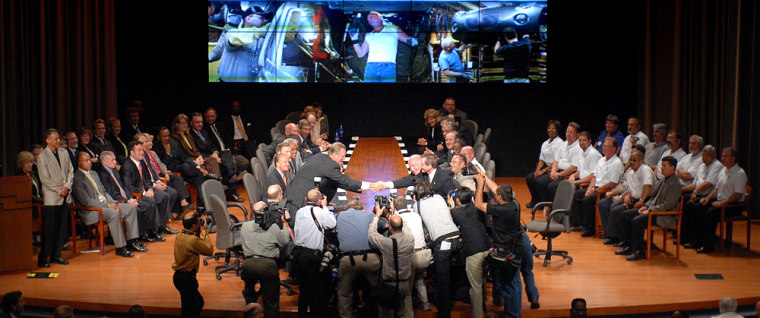The president of the United Auto Workers said Monday his union is not in the mood to make concessions during contract talks with U.S.-based automakers who say they need cost cuts to stay in business.
The comments came after the traditional handshake between officials from the UAW and General Motors Corp., the nation’s No. 1 automaker. The ceremony officially kicked off negotiations between the sides.
At least on the surface, it appears that the union and GM are far apart as they try to ink a new national contract before a Sept. 14 deadline. Ford Motor Co. also will seek concessions. Its talks opened Monday afternoon with a handshake ceremony in Dearborn. Ford Executive Chairman Bill Ford and Chief Executive Alan Mulally exchanged handshakes across a conference room table with UAW President Ron Gettelfinger and Vice President Bob King.
Bargaining with Chrysler Group started last week.
GM, which lost about $2 billion last year and still isn’t making money in North America, clearly will put concessions on the bargaining table.
“We know that these are going to be difficult contract negotiations,” Diana Tremblay, GM’s chief negotiator, said after the handshake at a GM-UAW human resources building along the Detroit River. “We know that we need to make some changes to make the business sustainable over the long term.”
But Gettelfinger said the union is not in a concessionary mode, and he also said a strike still is possible despite the precarious financial positions of the Detroit Three. He has said that the union will try for a pattern contract with one that extends to the others, but he said a target company has not been selected.
“That just depends on the tone of the negotiations,” Gettelfinger said.
Earlier, Gettelfinger smiled and shook hands with GM Chairman and CEO Rick Wagoner, while Tremblay shook hands with UAW Vice President Cal Rapson. All four had to lean across a table to complete the handshake for photographers.
This year’s auto talks have taken on a more urgent tone because the Detroit Three lost a combined $15 billion in 2006 and are in the midst of shrinking themselves and rolling out new vehicles in an effort to better compete with the Japanese. Industry analysts have said reducing labor costs is critical to the companies’ survival.
Ford is in the worst shape of the three, having mortgaged its factories to set up a $23.4 billion line of credit to cover losses and pay operating expenses while it restructures. Ford lost $12.6 billion last year and $282 million in the first quarter of this year, and it doesn’t expect to make money again until 2009.
Analysts say Ford likely will seek deeper concessions than the other two automakers, perhaps temporary wage cuts.
Gettelfinger wouldn’t say whether the UAW would treat Ford any differently than the other automakers due to its massive debt load and losses.
“They’ve got a lot of cash, by the way. That’s not an issue for us right now,” he said.
Gettelfinger also said this year’s talks are about defending America’s middle class and are not limited to wages and benefits in the auto industry.
The UAW, he said, already has helped the auto companies with health care cost concessions and local agreements to make individual factories more competitive.
“I think it’s fair to say we’ve given a lot,” he said.
Joe Laymon, Ford’s group vice president of labor affairs, said the union is no stranger to Ford’s financial position.
“I think Ron is well aware of the financial situation of Ford Motor Co.,” he said. “It’s no secret that our CEO-president said we recently took out the largest home loan in the history of mankind. If we were in great financial standing we would not have to have mortgaged the assets,” Laymon said.
He said the union and company have worked together on problems, including health care concessions and local agreements that make factories more competitive.
“The harsh reality, though, is with all the progress that we’ve made together, we still have a lot to get done during” these negotiations, Laymon said.
All three domestic automakers say the talks need to bring them labor cost parity with Japanese automakers, who make about $2,000 per car more in profits.
The Detroit automakers say their hourly labor costs are about $25 more than Toyota Motor Corp., Honda Motor Co. and Nissan Motor Co. when health care, pension, retiree and other costs are factored in.
Ford, though, really isn’t much different because the Detroit automakers all have the same problems, said Laurie Harbour-Felax, managing director at Stout Risius Ross Inc., who has done detailed studies of auto manufacturing costs.
“Ford is probably not as well-positioned as GM today ... but they still have the same issues around health care that are crippling them,” Harbour-Felax said.
All three must deal with rising health care costs and the “jobs bank,” in which companies pay workers most of their salaries when their assembly lines aren’t running. She said her studies have shown that the Detroit Three pay $1,200 to $1,500 per car in health care costs, far more than the Japanese automakers.
The UAW, however, has said that labor costs represent only 10 percent of the price of a new vehicle.
Health care is a major issue for GM, which paid $4.8 billion for it last year and has said it is the company’s largest competitive disadvantage.
